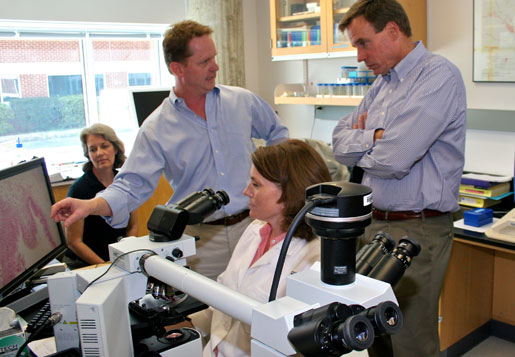Senator Warner visits VIMS to discuss oyster restoration strategies in the Chesapeake
U.S. Senator Mark Warner visited the Virginia Institute of Marine Science in July to discuss oyster-restoration strategies in the Chesapeake Bay. Warner’s visit coincided with a growing recognition among scientists, policymakers and industry that increased disease resistance, a local surge in oyster aquaculture, and recently announced federal restoration goals offer promising new opportunities in ongoing efforts to restore oysters to the Bay.
“Scientists at VIMS are applying their expertise to lead some great research into our efforts to restore oysters and other shellfish in the Chesapeake Bay,” Senator Warner said.
During his visit, Senator Warner visited the VIMS Oyster Hatchery, where he engaged Stan Allen and Roger Mann in a broad discussion of VIMS’ cutting-edge role in breeding disease-resistant oysters for aquaculture.
Allen, who heads the Aquaculture Genetics and Breeding Technology Center at VIMS, described his group’s efforts to domesticate oysters through selective breeding and genetic research. Allen said that his group’s overall goal is to “provide genetically superior brood stock to industry for use in aquaculture,” and noted that their success in developing disease-tolerant strains has now allowed them to focus on improving other production traits, such as growth and meat yield.
Mann, director of research and advisory service at VIMS, put the oyster restoration efforts in their broader, historical context, describing the growing recognition that restoration includes both ecological and economic goals, and that the focus of these goals may differ.
Senator Warner also met with Ryan Carnegie, research assistant professor in the VIMS Shellfish Pathology Laboratory. Carnegie leads the lab’s unique, 50-year study of MSX and Dermo, diseases that have helped push populations of Chesapeake Bay oysters to one percent of historical levels. The oyster’s increased disease tolerance to both MSX and Dermo strengthens the case for including harvest-free oyster reefs in restoration strategies. These sanctuaries would maximize the opportunity for oysters to produce disease-resistant offspring for Bay waters.
The most recent study of oyster aquaculture in the Commonwealth, by researchers with the Sea Grant Extension Program at VIMS, shows that Virginia’s oyster hatcheries sold 18 times more seed and larvae in 2008 than in 2007, and that they predicted an additional four-fold increase in sales in 2009.
The study also showed that 9.8 million farmed oysters went to market in 2008—up from 4.8 million in 2007, surpassing the industry prediction of 7.3 million.
VIMS Dean and Director John Wells says, “VIMS has some of the world’s leading oyster researchers, and we look forward to continuing our leadership role in oyster restoration, as well as in advancing new opportunities for oyster aquaculture.”![]()
















